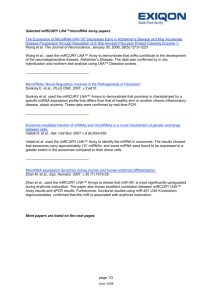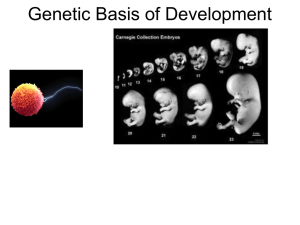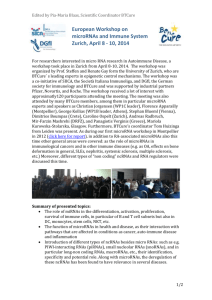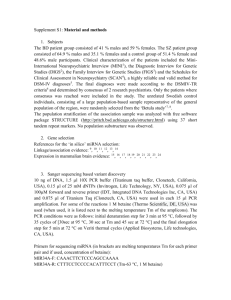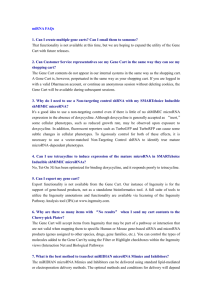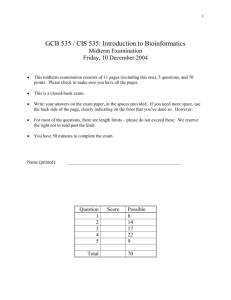Supplementary Methods (docx 92K)
advertisement
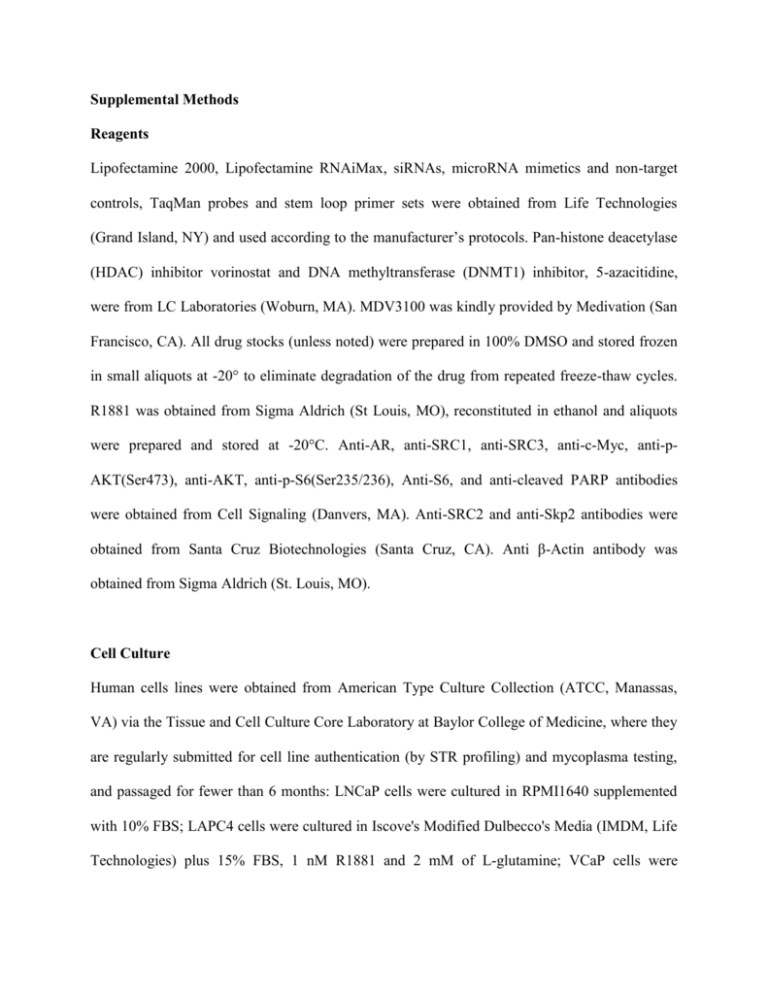
Supplemental Methods Reagents Lipofectamine 2000, Lipofectamine RNAiMax, siRNAs, microRNA mimetics and non-target controls, TaqMan probes and stem loop primer sets were obtained from Life Technologies (Grand Island, NY) and used according to the manufacturer’s protocols. Pan-histone deacetylase (HDAC) inhibitor vorinostat and DNA methyltransferase (DNMT1) inhibitor, 5-azacitidine, were from LC Laboratories (Woburn, MA). MDV3100 was kindly provided by Medivation (San Francisco, CA). All drug stocks (unless noted) were prepared in 100% DMSO and stored frozen in small aliquots at -20° to eliminate degradation of the drug from repeated freeze-thaw cycles. R1881 was obtained from Sigma Aldrich (St Louis, MO), reconstituted in ethanol and aliquots were prepared and stored at -20°C. Anti-AR, anti-SRC1, anti-SRC3, anti-c-Myc, anti-pAKT(Ser473), anti-AKT, anti-p-S6(Ser235/236), Anti-S6, and anti-cleaved PARP antibodies were obtained from Cell Signaling (Danvers, MA). Anti-SRC2 and anti-Skp2 antibodies were obtained from Santa Cruz Biotechnologies (Santa Cruz, CA). Anti β-Actin antibody was obtained from Sigma Aldrich (St. Louis, MO). Cell Culture Human cells lines were obtained from American Type Culture Collection (ATCC, Manassas, VA) via the Tissue and Cell Culture Core Laboratory at Baylor College of Medicine, where they are regularly submitted for cell line authentication (by STR profiling) and mycoplasma testing, and passaged for fewer than 6 months: LNCaP cells were cultured in RPMI1640 supplemented with 10% FBS; LAPC4 cells were cultured in Iscove's Modified Dulbecco's Media (IMDM, Life Technologies) plus 15% FBS, 1 nM R1881 and 2 mM of L-glutamine; VCaP cells were maintained in DMEM high glucose (Life Technologies) with 10% FBS and 1 nM R1881. All media were supplemented with 100 units/ml penicillin and 100 μg/ml streptomycin. Cells were maintained in a 5% CO2 incubator at 37°C. Exponentially growing cells were utilized for all described studies. Transfection of microRNA mimetics All microRNA (miRNA) mimetics or non-target controls (miRvana, Applied Biosystems) were transfected into LNCaP, LAPC4 and 22Rv1 cells at 30 nmol/L (final concentration) using Lipofectamine RNAiMAX (Life Technologies) according to the manufacturer’s instructions. Cells were incubated with the mimetics for 48-96 hours as indicated in each experiment. MTT assay Cells were plated in 24-well plates in medium containing 10% FBS and allowed to adhere for 24 hours. Then, miRNA mimetics were added, and the cells were incubated for an additional 96 hours. Cell viability was quantified by 3-(4,5-dimethylthiazol-2-yl)-2,5-diphenyltetrazolium bromide (MTT, obtained from Sigma-Aldrich) and expressed as a percentage of the nontargeting microRNA (miR-NT)-transfected wells. All experiments were repeated at least twice, with each experimental condition repeated at least in quadruplicate per experiment. RNA isolation and RT-qPCR Cells treated with vorinostat, 5-azacytidine, enzalutamide (MDV3100) or R1881 were harvested into Trizol. RNA was isolated by the addition of chloroform to the Trizol lysate, vigorously shaking the tube and centrifuging the tubes at 13,000 rpm (16,100 x g) for 3 minutes to separate the layers. The top, aqueous layer was pipetted into a clean 1.5 mL tube and 1 mL of 100% isopropanol was added to precipitate the RNA. Tubes were centrifuged at 13,000 rpm for 10 minutes at 4°C. The isopropanol was decanted and the RNA was washed with 70% molecular grade ethanol for 5 minutes. The ethanol was decanted and the RNA was air-dried. RNAse-free water was used to resuspend the RNA pellet. The RNA was quantified and utilized for reverse transcription (RT) reactions. To quantify microRNA expression levels following drug treatments, a stem loop primer and a TaqMan probe for each target microRNA was utilized (Life Technologies). Quantitative PCR was conducted utilizing a TaqMan hydrolysis probe for each target microRNA. Relative expression of each miR was normalized to the expression of RNU6B. For reverse transcription of total cell RNA for gene expression studies, a High Capacity Reverse Transcription kit (Life Technologies) and random hexamers were used according to the manufacturer’s protocol. The resulting cDNA was utilized for quantitative RT-PCR analysis of KLK3/PSA and TMPRSS2 gene expression and was performed with SYBR Green PCR master mix and gene specific primers using a StepOne Plus Real-time PCR system. Primer sequences are provided in Supplemental Table 1. Relative expression of each mRNA was normalized to the expression of β-Actin. Reverse Phase Protein Array (RPPA) footprint of the SiM-miRNAs in PC cells LNCaP PC cells were transfected with miRNA mimetics for 48 hrs, and assayed by RPPA using a panel of 157 antibodies (41 against phosphorylated epitopes, 4 against cleaved epitopes and 112 against total proteins) with the help of the Functional Proteomics/RPPA Core Facility (The University of Texas M.D. Anderson Cancer Center, Houston, Texas). Protein expression was quantified by MicroVigene and normalized using the R package SuperCurve1. We determined a proteomics signature of the microRNAs using the t-test, p-value<0.05, and fold change exceeding 1.10. Pathway analysis of corresponding genes for recurrently changed antibodies was performed using the ConsensusPathDB 2 software package. Hierarchical clustering and statistical analysis was performed using the R statistical analysis system. SDS-PAGE and immunoblot analyses LNCaP cells transfected with miR-NT or miR mimetics, were lysed with RIPA buffer. Lysates were cleared by centrifugation at 16,100 x g for 10 minutes. Protein estimation was conducted with a BCA kit (Thermo Scientific). Proteins were mixed with 6 X SDS-PAGE sample buffer and boiled for 5 minutes at 100°C. Proteins were separated on polyacrylamide gels and transferred to PVDF-FL (low fluorescence) membranes. Blots were blocked with LI-COR blocking buffer at room temperature for 30 minutes. Primary antibodies were added and incubated for 3 hours to overnight. Blots were washed with 1X TBST and incubated with IR680conjugated anti-mouse or IR-800-conjugated anti-rabbit secondary antibodies for 1 hour. Blots were washed and scanned on a LI-COR Odyssey scanner (LI-COR, Lincoln NE) and processed with Image Studio version 3.1 (LI-COR). All immunoblots were performed at least twice and representative blots are shown. Bioinformatic prediction for direct miRNA/mRNA binding Potential binding of miRNAs to 3’UTR of genes is evaluated using multiple criteria such as sequence similarity with miRNA seed, estimated free energy after binding, evolutionary conservation of the binding sites, and others. To examine which of the proteomic effects observed after transfection of SiM-miRNA mimetics could be explained via direct binding to the corresponding mRNAs, we combined the prediction for the SiM-miRNAs using five leading prediction engines, namely TargetScan3-6, PicTar 13 7, 8 , miRanda 9, 10 , mirDB 11, and DianaLab 12, . We used the union of all five prediction algorithms, so a miRNA/mRNA interaction was considered possible if predicted by even one of these five engines. This was done in order to have high sensitivity for predicted interactions. Integration of AGO HITS-CLIP and AGO PAR-CLIP data Publicly available Argonaute HITS-CLIP and PAR-CLIP datasets were interrogated using the Starbase compendium 14, 15 (http://starbase.sysu.edu.cn/). Enriched regions were intersected with the genes of interest AR, SRC1 (NCOA1), SRC2 (NCOA2), SRC3 (NCOA3), and ROCK1 using BEDTools16. MicroRNA seeds were matched to the peak regions using miRanda9 as described 17 . Data sets utilized were GSE57855, GSE43909, GSE28865, GSE32109, GSE41437, GSE43573, GSE41357, GSE42701, GSE43910, GSE43912, and GSE43911 17-31. Comparison of SiM-miRNA expression with AR transcriptional activity in PC tissues Gene expression datasets derived from LNCaP cells after silencing AR have been previously reported 32 . Gene expression differences were inferred utilizing the t-test and imposing a fold change exceeding 4/3x (p<0.05), using the R statistical system, resulting in an AR-dependent gene signature. In the Taylor et al. 33 dataset, we utilized the expression of each gene from the AR signature to calculate its respective z-score for each sample, relative to the normal prostate gland specimens available in that cohort. We then computed the sum z-score of all the AR- signature genes for each sample (the z-scores of downregulated genes were subtracted from the z-scores of upregulated genes), as described previously 33 , resulting in a corresponding gene signature activity score for each specimen. We next computed the Pearson Correlation Coefficient (PCC, p<0.05) between these gene signature activity scores and the expression level of each miRNA in the Taylor et al. 33 dataset, using the R statistical system as previously 34. A gene expression dataset derived from LNCaP cells after re-expressing miR-135a has been reported by Kroiss et al (GSE45620) 31. We evaluated the significant enrichment of AR-induced genes (genes suppressed by siAR) in the miR-135a transcriptomic footprint using the Gene Set Enrichment Analysis (GSEA) 35 method (q<0.25). Analysis of epigenetic marks in prostate cells in vitro ChIP Seq datasets for AR, GATA2, FOXA1, SRC1, SRC2, SRC3, CBP, p300 and Pol II have been previously reported 32 . We also used ChIP-Seq data of H3K4me3 and H3K27me3 from PrEC and LNCaP cells (GSE38685) 36 . For enhancer identification, we used H3K4me1, H3K4me2, and H3K27ac ChIP-Seq data in LNCaP cells 37 . Sequenced reads were mapped to the human genome UCSC build hg19/NCBI build 37 using BWA 38 . High-resolution genome- wide maps were derived and visualized in the UCSC Genome Browser (http://genome.ucsc.edu/) and using IGV software 39, 40. Read coverage at the genomic loci for miR-135a-5p, miR-221-5p, miR-1, and miR-31 was computed using BEDTOOLS 16 . To determine enrichment of a signal between PrEC and LNCaP cells at specific genomic loci, we first used a 50 kbp window both upstream and downstream of the locus of interest to establish the background signal. Then, we calculated the ratio [reads at regulation site, defined by enrichment of either H3k4me3 or h3k27me3]/[reads within 50 kbp of the locus in both directions] by Fisher’s exact test using the SciPy Python library 41. References for Supplemental Methods 1 Troncale S, Barbet A, Coulibaly L, Henry E, He B, Barillot E et al. NormaCurve: a SuperCurve-based method that simultaneously quantifies and normalizes reverse phase protein array data. PloS one 2012; 7: e38686. 2 Kamburov A, Wierling C, Lehrach H, Herwig R. ConsensusPathDB--a database for integrating human functional interaction networks. Nucleic acids research 2009; 37: D623-628. 3 Lewis BP, Burge CB, Bartel DP. Conserved seed pairing, often flanked by adenosines, indicates that thousands of human genes are microRNA targets. Cell 2005; 120: 15-20. 4 Friedman RC, Farh KK, Burge CB, Bartel DP. Most mammalian mRNAs are conserved targets of microRNAs. Genome Res 2009; 19: 92-105. 5 Garcia DM, Baek D, Shin C, Bell GW, Grimson A, Bartel DP. Weak seed-pairing stability and high target-site abundance decrease the proficiency of lsy-6 and other microRNAs. Nat Struct Mol Biol 2011; 18: 1139-1146. 6 Grimson A, Farh KK, Johnston WK, Garrett-Engele P, Lim LP, Bartel DP. MicroRNA targeting specificity in mammals: determinants beyond seed pairing. Mol Cell 2007; 27: 91-105. 7 Chen K, Rajewsky N. Natural selection on human microRNA binding sites inferred from SNP data. Nature genetics 2006; 38: 1452-1456. 8 Krek A, Grun D, Poy MN, Wolf R, Rosenberg L, Epstein EJ et al. Combinatorial microRNA target predictions. Nature genetics 2005; 37: 495-500. 9 Betel D, Wilson M, Gabow A, Marks DS, Sander C. The microRNA.org resource: targets and expression. Nucleic acids research 2008; 36: D149-153. 10 John B, Enright AJ, Aravin A, Tuschl T, Sander C, Marks DS. Human MicroRNA targets. PLoS Biol 2004; 2: e363. 11 Wong N, Wang X. miRDB: an online resource for microRNA target prediction and functional annotations. Nucleic acids research 2015; 43: D146-152. 12 Kiriakidou M, Nelson PT, Kouranov A, Fitziev P, Bouyioukos C, Mourelatos Z et al. A combined computational-experimental approach predicts human microRNA targets. Genes Dev 2004; 18: 1165-1178. 13 Paraskevopoulou MD, Georgakilas G, Kostoulas N, Vlachos IS, Vergoulis T, Reczko M et al. DIANA-microT web server v5.0: service integration into miRNA functional analysis workflows. Nucleic acids research 2013; 41: W169-173. 14 Li JH, Liu S, Zhou H, Qu LH, Yang JH. starBase v2.0: decoding miRNA-ceRNA, miRNA-ncRNA and protein-RNA interaction networks from large-scale CLIP-Seq data. Nucleic acids research 2014; 42: D92-97. 15 Yang JH, Li JH, Shao P, Zhou H, Chen YQ, Qu LH. starBase: a database for exploring microRNA-mRNA interaction maps from Argonaute CLIP-Seq and Degradome-Seq data. Nucleic acids research 2011; 39: D202-209. 16 Quinlan AR, Hall IM. BEDTools: a flexible suite of utilities for comparing genomic features. Bioinformatics 2010; 26: 841-842. 17 Hamilton MP, Rajapakshe K, Hartig SM, Reva B, McLellan MD, Kandoth C et al. Identification of a pan-cancer oncogenic microRNA superfamily anchored by a central core seed motif. Nat Commun 2013; 4: 2730. 18 Lin PC, Chiu YL, Banerjee S, Park K, Mosquera JM, Giannopoulou E et al. Epigenetic repression of miR-31 disrupts androgen receptor homeostasis and contributes to prostate cancer progression. Cancer research 2013; 73: 1232-1244. 19 Darnell RB. HITS-CLIP: panoramic views of protein-RNA regulation in living cells. Wiley Interdiscip Rev RNA 2010; 1: 266-286. 20 Erhard F, Haas J, Lieber D, Malterer G, Jaskiewicz L, Zavolan M et al. Widespread context dependency of microRNA-mediated regulation. Genome Res 2014; 24: 906-919. 21 Gottwein E, Corcoran DL, Mukherjee N, Skalsky RL, Hafner M, Nusbaum JD et al. Viral microRNA targetome of KSHV-infected primary effusion lymphoma cell lines. Cell Host Microbe 2011; 10: 515-526. 22 Haecker I, Gay LA, Yang Y, Hu J, Morse AM, McIntyre LM et al. Ago HITS-CLIP expands understanding of Kaposi's sarcoma-associated herpesvirus miRNA function in primary effusion lymphomas. PLoS Pathog 2012; 8: e1002884. 23 Haecker I, Renne R. HITS-CLIP and PAR-CLIP advance viral miRNA targetome analysis. Crit Rev Eukaryot Gene Expr 2014; 24: 101-116. 24 Kishore S, Jaskiewicz L, Burger L, Hausser J, Khorshid M, Zavolan M. A quantitative analysis of CLIP methods for identifying binding sites of RNA-binding proteins. Nat Methods 2011; 8: 559-564. 25 Lipchina I, Elkabetz Y, Hafner M, Sheridan R, Mihailovic A, Tuschl T et al. Genomewide identification of microRNA targets in human ES cells reveals a role for miR-302 in modulating BMP response. Genes Dev 2011; 25: 2173-2186. 26 Memczak S, Jens M, Elefsinioti A, Torti F, Krueger J, Rybak A et al. Circular RNAs are a large class of animal RNAs with regulatory potency. Nature 2013; 495: 333-338. 27 Neve RM, Chin K, Fridlyand J, Yeh J, Baehner FL, Fevr T et al. A collection of breast cancer cell lines for the study of functionally distinct cancer subtypes. Cancer cell 2006; 10: 515-527. 28 Pillai MM, Gillen AE, Yamamoto TM, Kline E, Brown J, Flory K et al. HITS-CLIP reveals key regulators of nuclear receptor signaling in breast cancer. Breast Cancer Res Treat 2014; 146: 85-97. 29 Skalsky RL, Corcoran DL, Gottwein E, Frank CL, Kang D, Hafner M et al. The viral and cellular microRNA targetome in lymphoblastoid cell lines. PLoS Pathog 2012; 8: e1002484. 30 Xue Y, Ouyang K, Huang J, Zhou Y, Ouyang H, Li H et al. Direct conversion of fibroblasts to neurons by reprogramming PTB-regulated microRNA circuits. Cell 2013; 152: 82-96. 31 Kroiss A, Vincent S, Decaussin-Petrucci M, Meugnier E, Viallet J, Ruffion A et al. Androgen-regulated microRNA-135a decreases prostate cancer cell migration and invasion through downregulating ROCK1 and ROCK2. Oncogene 2014; 0. 32 He B, Lanz RB, Fiskus W, Geng C, Yi P, Hartig SM et al. GATA2 facilitates steroid receptor coactivator recruitment to the androgen receptor complex. Proceedings of the National Academy of Sciences of the United States of America 2014. 33 Taylor BS, Schultz N, Hieronymus H, Gopalan A, Xiao Y, Carver BS et al. Integrative genomic profiling of human prostate cancer. Cancer cell 2010; 18: 11-22. 34 Geng C, Rajapakshe K, Shah SS, Shou J, Eedunuri VK, Foley C et al. Androgen receptor is the key transcriptional mediator of the tumor suppressor SPOP in prostate cancer. Cancer research 2014; 74: 5631-5643. 35 Subramanian A, Tamayo P, Mootha VK, Mukherjee S, Ebert BL, Gillette MA et al. Gene set enrichment analysis: a knowledge-based approach for interpreting genome-wide expression profiles. Proceedings of the National Academy of Sciences of the United States of America 2005; 102: 15545-15550. 36 Bert SA, Robinson MD, Strbenac D, Statham AL, Song JZ, Hulf T et al. Regional activation of the cancer genome by long-range epigenetic remodeling. Cancer cell 2013; 23: 9-22. 37 Wang D, Garcia-Bassets I, Benner C, Li W, Su X, Zhou Y et al. Reprogramming transcription by distinct classes of enhancers functionally defined by eRNA. Nature 2011; 474: 390-394. 38 Li H, Durbin R. Fast and accurate short read alignment with Burrows-Wheeler transform. Bioinformatics 2009; 25: 1754-1760. 39 Robinson JT, Thorvaldsdottir H, Winckler W, Guttman M, Lander ES, Getz G et al. Integrative genomics viewer. Nat Biotechnol 2011; 29: 24-26. 40 Thorvaldsdottir H, Robinson JT, Mesirov JP. Integrative Genomics Viewer (IGV): highperformance genomics data visualization and exploration. Brief Bioinform 2013; 14: 178-192. 41 Olivier BG, Rohwer JM, Hofmeyr JH. Modelling cellular processes with Python and Scipy. Molecular biology reports 2002; 29: 249-254.


